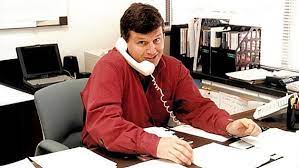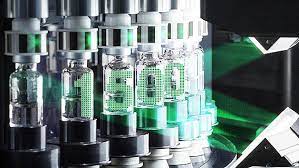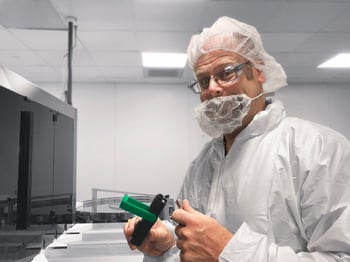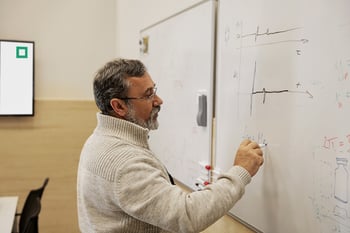In our interview series "Inspection around the world" we take a look behind the scenes of inspection at Syntegon. Behind each machine stands a team of experts – and Sean Willis, Director of Project Management and North American Inspection Sales Support is one of them.
Of Service and Sushi
In our interview series "Inspection around the world" we take a look behind the scenes of inspection at Syntegon. Behind each machine stands a team of experts – and Sean Willis, Director of Project Management and North American Inspection Sales Support is one of them. Over the last 35 years he and his team have been instrumental in establishing customer relations build on trust and satisfaction. In the interview, Sean talks about how the industry has changed over time, the importance of customer focus – and about the perks and perils of international travel.
Sean, you started in the very hands-on role of field service engineer. What did that time in your career teach you?
Sean: In 1988, when I started working as a field service engineer for what was Eisai Machinery back then, the company had just moved their US office to Allendale, New Jersey, from Pennsylvania. Unfortunately, the previous Field Service Engineers left after the move, so when I started, I was the only engineer at that time. This meant there had been a temporary lapse in customer relations and service support. When I started reestablishing relationships with our customers, I quickly noticed how much impact I had with that. So, I spent about a year visiting our US customers, reviewing their machine conditions and parts needs. Real grassroots work that taught me something I still believe in today: the cornerstone of our success is to keep in touch with our customers and provide support and solutions throughout everything we do. Their needs have to be the focus for all teams, be it field service, sales, marketing or R&D.

You have been with first Eisai, then Bosch and now Syntegon for 35 years. Which experiences were most memorable for you?
Sean: The big first-time developments and projects stand out in my mind. When I started, we offered automatic inspection machines (AIM) for particle inspection and were using our patented Static Division (SD) system, which made us unique as well as effective. Then, in 1993, Eisai developed the first camera-based cosmetic inspection machine. I installed it at the customer’s site. When we finished the SAT and I saw the machine go into production for the very first time, I knew I had witnessed a moment to remember. Today, particle and camera-based cosmetic inspection is integrated into each of our AIM machines models. The AIM 257 series, which we developed in the late 90s, is still the most common machine in North America. Together with our customers, we made that shift in the industry away from particle inspection alone and towards combined machines and I got to be part of it.
Speaking of change – what else is different now than when you started?
Sean: Globalization has had an impact on how we build and test machines, especially in the last 10 years. Since North America is an economically influential market for pharmaceutical equipment, companies from all over the world have had to adapt more and more to US guidelines and regulatory standards. Machine production in Europe and the Far East have had to comply with the UL safety standards as well as other regulations because it is what North American customers require. Also, requirements for increased inspection capability for container closure integrity testing (CCIT) and improved detection of products that are difficult to inspect with standard design approach, have prompted the need for deep learning studies and the use of artificial intelligence (AI) to improve inspection capability while filtering false rejection influences.
Get inspired with regular updates on technologies and services, case studies, webinar offers and events.

Your success is in no small part due to your collaboration with colleagues in Japan and Germany. What is your experience with being part of an international team?
Sean: Our strengths complement each other and make us more impactful and versatile as a whole. We also share a sense of camaraderie and a commitment to delivering good service, even if it means spanning different time zones. Just a few weeks ago a US customer called us at night with an urgent problem concerning their software. We called our colleagues in Japan as it was already the next morning for them. They prepared all the information we needed so that we were able to provide the customer with a solution the next morning. We are in the midst of performing an FAT for a machine built in Germany that has integrated CCIT, and the collaboration, teamwork and professionalism was a great experience and satisfying for our customer and for myself.
Do you get to meet your international colleagues often?
Sean: Travel has always been an important part of my work life. At one point, it made up 80 percent of it. Naturally, I travelled to Japan often. My first exposure to sushi was a bit of a culture shock, which I at least partly attribute to my Japanese colleagues starting me off with the most unusual pieces they could lay their hands on. The first time I travelled to Germany, on the other hand, Wiener Schnitzel became an instant favorite of mine. I travel a lot less now in my current role, but when I do, I very much enjoy seeing my colleagues from around the world face to face. The memories are forever, but meeting and working with the younger staff and seeing their enthusiasm and passion is very encouraging and I feel satisfied that the inspection products that I have been so close to for so many years have a bright future.




